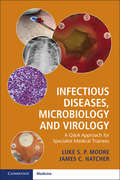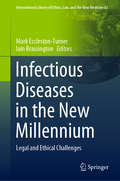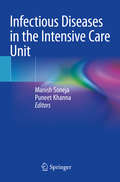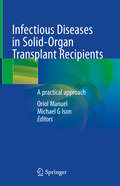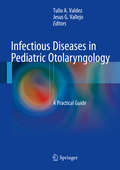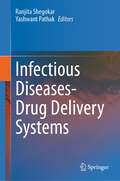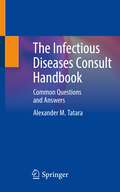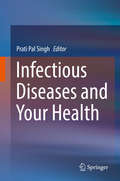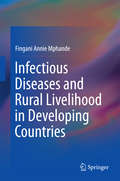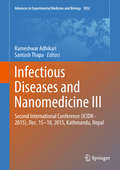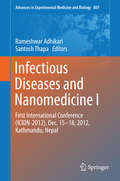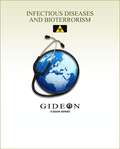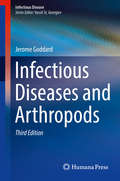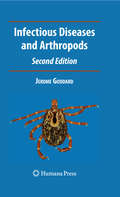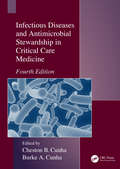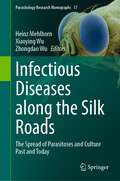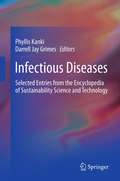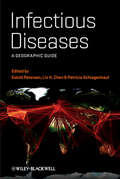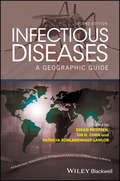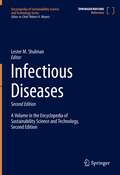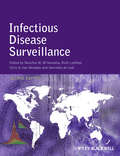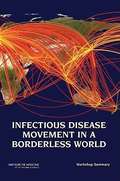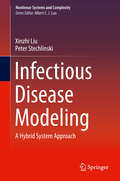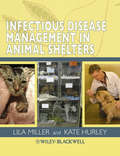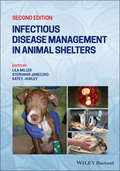- Table View
- List View
Infectious Diseases, Microbiology and Virology: A Q&A Approach for Specialist Medical Trainees
by Luke S. Moore James C. HatcherAn essential resource for practitioners in infectious diseases and microbiology, studying for the new FRCPath Part 1 infection examination accredited by the Royal College of Pathologists, and trainees sitting the membership exams of the Royal College of Physicians. Including over 300 multiple choice questions in an exam-style Q&A format, this guide provides an invaluable revision platform for domestic and international trainees alike, with scope to present infection-based support for other medical specialties, where infection forms a core component, including intensive care. Authored by leading specialists in infectious diseases and microbiology, this invaluable training guide is the first of its kind to cover both undergraduate and postgraduate material in infectious diseases. Mapping directly from the FRCPath and RCP infection curricula, students are able to explore areas of curriculum to gain knowledge and optimise decision-making skills, under pressure.
Infectious Diseases in the New Millennium: Legal and Ethical Challenges (International Library of Ethics, Law, and the New Medicine #82)
by Mark Eccleston-Turner Iain BrassingtonThis book examines the often tough questions raised by infectious diseases through essays that explore a host of legal and ethical issues. The authors also offer potential solutions in order to ensure that past errors are not repeated in response to future outbreaks. The essays touch on a number of key themes, including institutional competence, the accountability and responsibility of non-state actors, the importance of pharmaceuticals, and the move towards a rights-based approach in global health.Readers gain insights into such important questions as follows: How can we help victims in other countries? What (if any) responsibility should be placed upon international organizations whose actions exacerbate infectious diseases? How can we ensure that pharmaceutical research helps all communities, even those who cannot afford to pay for the products? While broadly covering global health law, the book adopts an inter-disciplinary approach that draws on public international law, philosophy, international relations, human rights law, and healthcare economics. As such, it is a valuable resource for academic libraries, appealing to scholars and postgraduates engaged in relevant research, as well as to those engaged with global health and policy at the international level.
Infectious Diseases in the Intensive Care Unit
by Manish Soneja Puneet KhannaInfections in intensive care is a very broad topic, and this book provides concise yet comprehensive coverage. It focuses on the appropriate and judicious use of microbiological, radiological and point-of-care tests in diagnostic work-ups and evidence-based management protocols. Moreover, it offers essential information on the diagnosis and management of commonly encountered infections in the intensive care unit, making it a handy ready-reference manual for intensivists.
Infectious Diseases in Solid-Organ Transplant Recipients: A practical approach
by Oriol Manuel Michael G IsonThis book describes a practical approach to the diagnosis, management, and prevention of infectious complications in solid-organ transplant (SOT) candidates and recipients, based on both up-to-date clinical evidence and state of the art expert opinion from world-renowned experts in the field. The book is divided into three parts, the first of which explains risk assessment and the general approach to infectious diseases in the pre-, peri-, and early and late post-transplant periods. The remaining two sections address the prevention and treatment of infection with particular pathogens and the management of specific syndromes, such as pneumonia, CNS infections, UTIs, and skin infections. Infections in SOT recipients – often due to multidrug-resistant organisms – represent a major challenge. Preventive strategies need to be adapted according to the type of allograft and period after transplantation. Moreover, toxicity and drug interaction with immunosuppressive drugs must be taken into consideration when treating infectious complications. In explaining in depth how best to ensure allograft and patient survival, this book will be of value to infectious disease specialists and transplant physicians at all levels of experience.
Infectious Diseases in Pediatric Otolaryngology
by Tulio Valdez Jesus VallejoThis quick reference on pediatric infectious diseases of the ear, nose, and throat provides reliable assistance in decision-making and management. To this end, numerous diagnostic and treatment algorithms are included. Practicing pediatricians, primary care practitioners, and otolaryngologists will all find the book to be an invaluable aid. This book helps the otolaryngologist who is uncertain of the best antibiotic or duration of treatment for a particular condition and instruct the pediatrician on when to refer to an otolaryngologist for surgical management. The approach is multidisciplinary, with contributions from both pediatric otolaryngologists and pediatric infectious disease physicians.
Infectious Diseases Drug Delivery Systems
by Ranjita Shegokar Yashwant PathakThe disability-adjusted life year (DALY) is a generic measure of health effect that can be used in cost-effectiveness analysis as an alternative to the quality-adjusted life year (QALY). Infectious diseases are one of the major to cause significant losses of DALY and QALY. Human infectious diseases are disorders that are triggered by the micro-organisms such as bacteria, fungi, viruses, or parasites. The majority of such diseases are contagious and create a public health menace. There are several reasons why infectious diseases are deadly diseases, and one of the primary reasons is the drug resistance developed over time. Drug resistance-associated mutations are linked to increasing drug efflux, modifications of the drugs, or their targets. Every year, new drugs are being approved by FDA to treat infectious diseases. Nonetheless, the infectious diseases will undoubtedly persist as permanent and main threats to humanity for now and in the future.A total of four books are covered under the series of Infectious drug diseases.- Malarial drug delivery systems- Tubercular drug delivery systems- Viral drug delivery systems- Infectious disease drug delivery systemsInfectious diseases are the world’s greatest killers that present one of the most significant health and security challenges. Humans have lived with emerging and re-emerging pathogens since before the documented history of civilization. The only determining fact today is - If the situation is “worse” or “better” than in past. The answer is probably “worse”, may be due significant increase in human population, increased cross-continent mobility, imbalanced (stressed) life style, irregular food habits leading to compromised innate immunity and over or under practiced hygiene routine. When the incidence of such a disease in people increases over 20 years or threatens to increase, it is called an “emerging” disease, and a growing number have made watch lists and headlines in nearly every country -like highly pathogenic H5N1 avian influenza, severe acute respiratory syndrome (SARS), Ebola virus, food- and waterborne illnesses, and a range of antimicrobial-resistant bacterial diseases TB. This book addresses current and new therapy developments in treating such infectious diseases, updates on finding new drugs, identification of innovative diagnostic methods, understanding of disease research models and clinical trials performances of new treatment modalities.Audiences from a broad range of groups, from researchers, academicians, and public health bodies to regulatory experts, can benefit from the compiled information to learn more about patient needs and current research advances in the field of infectious diseases and related research.
The Infectious Diseases Consult Handbook: Common Questions and Answers
by Alexander M. TataraThis book is an evidence-based guide for some of the most common consult questions asked of a first-year infectious diseases (ID) fellow working in an academic teaching hospital. Divided into sections based on pathogen and organ system, each covered topic includes reviews of the latest published literature in succinct subsections that can be easily referenced. The book can be read cover to cover as an introduction to clinical infectious diseases through the eyes of an ID fellow or used as a reference in real-time when on clinical service. Written throughout the fellowship of an ID fellow, this handbook shares the quintessential ID topics most commonly encountered on the consult service. From global pandemics to the emergence of drug-resistant superbugs, interest in infectious diseases has never been higher. ID experts weigh in daily on a variety of cases ranging from simple urinary tract infections to devastating sepsis in patients with recent organ transplantation. The ID consult service can be overwhelming given the breadth of infectious diseases that affect our patients. This handbook offers an introductory yet comprehensive resource to professionals, practitioners, students, and fellows.
Infectious Diseases and Your Health
by Prati Pal SinghInfectious Diseases and Your Health has the potential to impact and improve your life, and the lives of your loved ones. Every day, nearly 40, 000 people including small children and women die of infectious diseases. Many of these innocent lives could be saved. Your journey through the pages of this book will take you to an amazing world of infectious diseases. You will learn about various infectious diseases, how they can affect your life, the problems associated with their treatment and prevention, and how to overcome these problems. Additionally, you will hear the success story of new drug research, be introduced to the hard facts, and find fascinating pictures of microorganisms and parasites. The book provides instant solutions to several of your concerns about infectious diseases, and you will learn to live a highly productive, long and healthy life. So, join thousands of readers of this book worldwide, enhance your life and the lives of your loving family, become an informed healthy citizen, and contribute to achieving the UN’s Sustainable Development Goals. Let us never forget: life and quality of life are very precious.
Infectious Diseases and Rural Livelihood in Developing Countries
by Fingani Annie MphandeThis book focuses on the effects of rural livelihood and the impact of infectious diseases on health and poverty. It explores cultures and traditions in developing countries and their role in infectious-disease management and prevention. It highlights the associated healthcare systems and how these have contributed to some of the challenges faced, and goes on to elaborate on the significance of community involvement in infectious-disease prevention, management and control. It also emphasizes the importance of surveillance and setting up strategies on infectious-disease management that are favourable for poor communities and developing countries. Infectious Diseases and Rural Livelihood in Developing Countries allows students, researchers, healthcare workers, stakeholders and governments to better understand the vicious cycle of health, poverty and livelihoods in developing countries and to develop strategies that can work better in these regions.
Infectious Diseases and Nanomedicine III: Second International Conference (icidn - 2015), Dec. 15-18, 2015, Kathmandu, Nepal (Advances in Experimental Medicine and Biology #1052)
by Santosh Thapa Rameshwar AdhikariThis book gathers selected peer-reviewed papers presented at the Second International Conference on Infectious Diseases and Nanomedicine (ICIDN), held in Kathmandu, Nepal on December 15–18, 2015. It also includes invited papers from the leading experts in the related fields. The book highlights the importance of “Interdisciplinary Collaborative Research for Innovation in the Biomedical Sciences,” the motto of the ICIDN conference. In particular, it addresses interdisciplinary scientific approaches for systematic understanding of the biology of major human infectious diseases and their treatment regimes by applying the tools and techniques of nanotechnology. It also provides cutting-edge information on infectious diseases and nanomedicine, focusing on various aspects of emerging infectious diseases: cellular and molecular microbiology; epidemiology and infectious disease surveillance; antimicrobials, vaccines and alternatives; drug design, drug delivery and tissue engineering; nanomaterials and biomedical materials.
Infectious Diseases and Nanomedicine II
by Santosh Thapa Rameshwar AdhikariThe book addresses the interdisciplinary scientific approach for the systemic understanding of connections between major human diseases and their treatment regime by applying the tools and techniques of nanotechnology. It also highlights the interdisciplinary collaborative researches for innovation in Biomedical Sciences. The book is a second volume which presents collection of best papers presented in the First International Conference on Infectious Diseases and Nanomedicine held during Dec. 15-18, 2012 in Kathmandu, Nepal. The book focuses mainly on the topics: emerging infectious diseases; antimicrobial agents, vaccines and immunity; drug design, drug delivery and tissue engineering and nanomaterials and biomedical materials.
Infectious Diseases and Bioterrorism 2010 edition
by Gideon Informatics Dr Stephen BergerInfectious Diseases and Bioterrorism is one in a series of GIDEON ebooks which summarize the status of individual infectious diseases, in every country of the world. Data are based on the GIDEON web application (www.gideononline.com) which relies on standard text books, peer-review journals, Health Ministry reports and ProMED, supplemented by an ongoing search of the medical literature. Chapters are arranged alphabetically, by disease name. Each section is divided into four sections: 1. Descriptive epidemiology2. Summary of clinical features3. Status of the disease in Bioterrorism4. References There are 347 generic infectious diseases in the world today. 41 of these are considered potential agents of Bioterrorism.
Infectious Diseases and Arthropods (Infectious Disease Ser.)
by Jerome GoddardWith the exception of a few tropical medicine schools worldwide, current medical education programs include almost zero discussion of the interface between infectious diseases and entomology. That is why this book was initially published in the first edition almost 17 years ago. The third edition of this valuable infectious disease entomology book updates all existing chapters with the newest scientific developments described in the medical and entomological literature in addition to covering 10 entirely new topics not addressed in previous editions, which include: · arthropod identification controversies · early beginnings of public health and disease control · red-meat allergy · updates on vaccine development for dengue and malaria · discussion of Chikungunya and Zika viruses · American Boutonnneuse Fever · the newest controversies in Lyme disease · recent findings of viruses in ticks · bed bug bite reactions · Morgellons disease (an imaginary infectious disease)
Infectious Diseases and Arthropods
by Jerome GoddardIn this second edition of Infectious Diseases and Arthropods, Jerome Goddard summarizes the latest thinking about the biological, entomological, and clinical aspects of the major vector-borne diseases around the world. His book covers mosquito-, tick-, and flea-borne diseases, and a variety of other miscellaneous vector-borne diseases, including Chagas' disease, African sleeping sickness, onchocerciasis, scrub typhus, and louse-borne infections. The author provides for each disease a description of the vector involved, notes on its biology and ecology, distribution maps, and general clinical guidelines for treatment and control. Among the diseases fully discussed are malaria, dengue and yellow fevers, lymphatic filariasis, spotted fevers, ehrlichiosis, lyme disease, tularemia, and plague. Other arthropod-caused or related problems-such as myiasis, imaginary insect or mite infestations, and arthropod stings and bites-are also treated. At a time when vector-borne diseases are spreading ever more widely, Infectious Diseases and Arthropods provides physicians, infectious disease specialists, medical entomologists, and public health officials with an up-to-date, readily accessible, gold-standard reference source.
Infectious Diseases and Antimicrobial Stewardship in Critical Care Medicine
by Cheston B. Cunha, Burke A. CunhaInfectious Diseases and Antimicrobial Stewardship in Critical Care Medicine 4E has been fully updated and revised. The clinical diagnostic approach to common infectious disease problems in the CCU is the underlying theme in the book. Emphasized throughout is the importance of formulating an accurate early presumptive clinical syndromic diagnosis which is the basis for selecting optimal initial antimicrobial therapy in the CCU. Without an accurate presumptive clinical diagnosis, effective therapy is unlikely at best. Based on the most probable clinical diagnosis, optimal antibiotic empiric therapy, based on antimicrobial stewardship principles, minimizes resistance and antibiotic complications in the CCU. This new edition features chapters that explain the tenets of differential diagnostic reasoning, differential diagnostic characteristics of fever patterns in the CCU. The proper interpretation of rapid diagnostic tests, in the appropriate clinical context, is included. The diagnostic importance of cardinal clinical findings, particularly when combined, in the appropriate clinical context is emphasized and remains the basis for clinical problem solving in the CCU. Uniquely, critical diagnostic physical findings in the CCU, including color atlas of diagnostic eye findings, are included as important diagnostic determinants in the CCU. Written by infectious disease clinicians for CCU consultants, Infectious Diseases and Antimicrobial Stewardship in Critical Care Medicine 4E remains a useful evidence based and experience tempered key clinical resource for infectious disease problems in the CCU. Key Features Essentials of the tenets of clinical diagnostic reasoning is explained as it relates to formulating a rapid and accurate clinical syndromic diagnosis in the CCU The diagnostic significance of fever patterns and their relationship to the pulse rate in the proper clinical context is explained in depth as related to the CCU setting Formulating an accurate early clinical syndromic diagnosis is presented as essential since it is the basis of effective empiric antibiotic therapy in the CCU How to combine key non-specific laboratory and imaging findings to increase diagnostic specificity and diagnostic probability in the CCU is presented Clinical perspective on the proper interpretation of the clinical significance of rapid diagnostic test results in the CCU is included A clinical approach to apparent "antibiotic failure" in the CCU is presented either due to actual antibiotic failure or seeming but unrelated non-antibiotic failure Section focuses on the practical aspects of antimicrobial stewardship particularly as related to optimizing dosing effectiveness while minimizing resistance and adverse effects in the CCU
Infectious Diseases along the Silk Roads: The Spread of Parasitoses and Culture Past and Today (Parasitology Research Monographs #17)
by Heinz Mehlhorn Xiaoying Wu Zhongdao WuThe heart of this volume is exploring the links between human disease spread and the broad Silk Road trading networks which connect Eurasian civilizations past and today. Compiled by an international team of subject authors, this book includes two themed parts. Readers are first introduced into history naming, former, present and future routes of the Silk Road, representing the longest trade way and culture diffuser in the world. The second part contains the main book focus and addresses medical research as well as individual diseases and parasite groups from the region in detail. By drawing an arc between the past and present disease situation, the authors trace how parasites and vectors spread around the globe, and what impact infectious diseases had and will have upon human civilizations.Through its interdisciplinary character this book will be enjoyed by interested readers from the fields of parasitology and palaeoparasitology, medical sciences and public health, as well as cultural history.
Infectious Diseases
by D. Jay Grimes Phyllis KankiInfectious Diseases: Selected Entries from the Encyclopedia of Sustainability Science and Technology presents authoritative, peer-reviewed contributions from leading experts on a wide range of major infectious diseases of global importance. Infectious diseases account for more than 17 million deaths each year worldwide. While modern medicine and technology have diminished the threat of many of these pathogens in high-income countries, the ever present threats of re-emerging infections, population mobility, natural disasters, and pathogen genetic variability are but some of the reasons for the dynamic threat of this broad category of risks to human health. An indispensable resource for students and scientists, the volume also covers some of the new technologies currently under development for infectious disease prevention, treatment, and eradication. The greater part of the infectious disease burden remains in the tropics, where low and middle-income countries lack the resources, infrastructure, and health systems to mount or sustain control efforts. Many contributions describe the efforts of the scientific research community and international donor agencies to achieve the integrated goals of vigilant surveillance, improved and cost-effective diagnostics, and treatment for sustainable disease control.
Infectious Diseases: A Geographic Guide
by Eskild Petersen Lin H. Chen Patricia SchlagenhaufThis concise and practical guide describes infections in geographical areas and provides information on disease risk, concomitant infections (such as co-prevalence of HIV and tuberculosis) and emerging bacterial, viral and parasitic infections in a given geographical area of the world. Infectious Diseases: A Geographic Guide is divided according to United Nations world regions and addresses geographic disease profiles, presenting symptoms and incubation periods of infections. Each chapter contains a section on the coverage of the childhood vaccination programs in the countries included in that region. Chapters also include descriptions of infectious disease risk and problems with resistant bacteria in each region (e.g. antibiotic resistance in Salmonella infections in Southeast Asia). For the clinician, this book is a tool to generate differential diagnoses by considering the geographical history, as well the presenting symptoms and duration of illness. For the travel medicine specialist, this book provides information on risks of different diseases at various destinations and is particularly useful in advising long-term travelers.
Infectious Diseases: A Geographic Guide
by Eskild Petersen Lin Hwei Chen Patricia Schlagenhauf-LawlorThis concise and practical guide describes infections in geographical areas and provides information on disease risk, concomitant infections (such as co-prevalence of HIV and tuberculosis) and emerging bacterial, viral and parasitic infections in a given geographical area of the world. Infectious Diseases: A Geographic Guide is divided according to United Nations world regions and addresses geographic disease profiles, presenting symptoms and incubation periods of infections. Each chapter contains a section on the coverage of the childhood vaccination programs in the countries included in that region. Chapters also include descriptions of infectious disease risk and problems with resistant bacteria in each region (e. g. antibiotic resistance in Salmonella infections in Southeast Asia). For the clinician, this book is a tool to generate differential diagnoses by considering the geographical history, as well the presenting symptoms and duration of illness. For the travel medicine specialist, this book provides information on risks of different diseases at various destinations and is particularly useful in advising long-term travelers.
Infectious Diseases (Encyclopedia of Sustainability Science and Technology Series)
by Lester M. ShulmanThis volume on Infectious Diseases in an Encyclopedia of Sustainability Science and Technology (ESST) addresses the needs of health care providers and policy makers as well as scientists and engineers. Most of chapters in this volume deal with infectious diseases that directly affect humans, including the detailed characterization of specific pathogens, how they reproduce, how they are transmitted, and the means available to control, eliminate, or eradicate them. In this revised and updated second edition, the number of human infectious diseases covered has been significantly expanded. Other new chapters deal with current leading edge technologies for the diagnosis of pathogens; surveillance including environmental and syndromic surveillance for pathogens; requirements for quality assurance, quality control and the need for biological standards and controls to sustain high quality diagnosis and surveillance; the use of big data for personalized medicine; modeling infectious diseases; zoonotic and vector borne diseases; disease prevention with antibiotics, antivirals and vaccines; and factors that affect ecological balances leading to emergence of new diseases such as climate change and deforestation. Finally, infectious diseases that affect livestock and culture of plants for food, comfort and beauty are also addressed, since we must also consider them when discussing sustainability of humans in our ecosystem.
Infectious Disease Surveillance
by Henriette De Valk Nkuchia M. M'Ikanatha Chris A. Van Beneden Ruth LynfieldThis fully updated edition of Infectious Disease Surveillance is for frontline public health practitioners, epidemiologists, and clinical microbiologists who are engaged in communicable disease control. It is also a foundational text for trainees in public health, applied epidemiology, postgraduate medicine and nursing programs. The second edition portrays both the conceptual framework and practical aspects of infectious disease surveillance. It is a comprehensive resource designed to improve the tracking of infectious diseases and to serve as a starting point in the development of new surveillance systems. Infectious Disease Surveillance includes over 45 chapters from over 100 contributors, and topics organized into six sections based on major themes.Section One highlights the critical role surveillance plays in public health and it provides an overview of the current International Health Regulations (2005) in addition to successes and challenges in infectious disease eradication. Section Two describes surveillance systems based on logical program areas such as foodborne illnesses, vector-borne diseases, sexually transmitted diseases, viral hepatitis healthcare and transplantation associated infections. Attention is devoted to programs for monitoring unexplained deaths, agents of bioterrorism, mass gatherings, and disease associated with international travel.Sections Three and Four explore the uses of the Internet and wireless technologies to advance infectious disease surveillance in various settings with emphasis on best practices based on deployed systems. They also address molecular laboratory methods, and statistical and geospatial analysis, and evaluation of systems for early epidemic detection.Sections Five and Six discuss legal and ethical considerations, communication strategies and applied epidemiology-training programs. The rest of the chapters offer public-private partnerships, as well lessons from the 2009-2010 H1N1 influenza pandemic and future directions for infectious disease surveillance.
Infectious Disease Movement in a Borderless World: Workshop Summary
by Institute of Medicine of the National AcademiesModern transportation allows people, animals, and plants--and the pathogens they carry--to travel more easily than ever before. The ease and speed of travel, tourism, and international trade connect once-remote areas with one another, eliminating many of the geographic and cultural barriers that once limited the spread of disease. Because of our global interconnectedness through transportation, tourism and trade, infectious diseases emerge more frequently; spread greater distances; pass more easily between humans and animals; and evolve into new and more virulent strains. The IOM's Forum on Microbial Threats hosted the workshop "Globalization, Movement of Pathogens (and Their Hosts) and the Revised International Health Regulations" December 16-17, 2008 in order to explore issues related to infectious disease spread in a "borderless" world. Participants discussed the global emergence, establishment, and surveillance of infectious diseases; the complex relationship between travel, trade, tourism, and the spread of infectious diseases; national and international policies for mitigating disease movement locally and globally; and obstacles and opportunities for detecting and containing these potentially wide-reaching and devastating diseases. This document summarizes the workshop.
Infectious Disease Modeling
by Xinzhi Liu Peter StechlinskiThis volume presents infectious diseases modeled mathematically, taking seasonality and changes in population behavior into account, using a switched and hybrid systems framework. The scope of coverage includes background on mathematical epidemiology, including classical formulations and results; a motivation for seasonal effects and changes in population behavior, an investigation into term-time forced epidemic models with switching parameters, and a detailed account of several different control strategies. The main goal is to study these models theoretically and to establish conditions under which eradication or persistence of the disease is guaranteed. In doing so, the long-term behavior of the models is determined through mathematical techniques from switched systems theory. Numerical simulations are also given to augment and illustrate the theoretical results and to help study the efficacy of the control schemes.
Infectious Disease Management in Animal Shelters
by Lila Miller Dvm Kate Hurley MpvmInfectious Disease Management in Animal Shelters is a comprehensive guide to preventing, managing, and treating disease outbreaks in shelters. Emphasizing strategies for the prevention of illness and mitigation of disease, this book provides detailed, practical information regarding fundamental principles of disease control and specific management of important diseases affecting dogs and cats in group living environments. Taking an in-depth, population health approach, the text presents information to aid in the fight against the most significant and costly health issues in shelter care facilities.
Infectious Disease Management in Animal Shelters
by Lila Miller Stephanie Janeczko Kate F. HurleySince the publication of the first edition of Infectious Disease Management in Animal Shelters in 2009, research and practice in the field of shelter medicine have advanced significantly. This updated second edition of that seminal work provides the most up-to-date and comprehensive guide to preventing, managing, and treating infectious diseases affecting cats, dogs and exotic small companion mammals in animal shelters. Throughout the book, the authors—noted experts on the topic—bridge the gap between medicine (both individual and group) and management. The book is filled with practical strategies that draw on the latest research and evidence-based medicine as well as the authors’ personal experience in the field. While the text highlights strategies for the prevention of illness and mitigation of disease spread, the book also contains practical information on treatment and considerations for adoption. This important text: Offers the only book dedicated to the topic of infectious disease management in shelters Presents guidelines for general management and disease prevention and control in cats and dogs Includes shelter medicine’s core principles of humane population management in the context of supporting shelters’ goals for preserving welfare, saving lives and protecting human health Contains a new chapter on exotic companion mammals Written for shelter veterinarians, managers, and workers, the revised second edition of Infectious Disease Management in Animal Shelters is the only book to focus exclusively on infectious diseases in the shelter setting, blending individual animal care with a unique herd health perspective.
